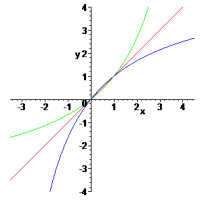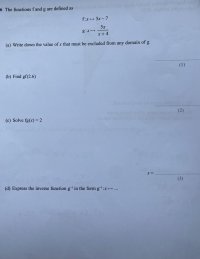You are using an out of date browser. It may not display this or other websites correctly.
You should upgrade or use an alternative browser.
You should upgrade or use an alternative browser.
Functions
- Thread starter CAD60
- Start date
mmm4444bot
Super Moderator
- Joined
- Oct 6, 2005
- Messages
- 10,962
Posting Guidelines (Summary)
Welcome to our tutoring boards! :) This page summarizes main points from our posting guidelines. As our name implies, we provide math help (primarily to students with homework). We do not generally post immediate answers or step-by-step solutions. We don't do your homework. We prefer to help...
www.freemathhelp.com
Otis
Elite Member
- Joined
- Apr 22, 2015
- Messages
- 4,592
Hi CAD60. I'm not familiar with the notation in parts (b) and (c).
I suppose that gf(2.6) could refer to either a composition of functions or a product of functions. Can you clarify?
For a composition, I've seen [imath]\color{blue}(g \circ f)(2.6)\color{black}[/imath] and
[imath]\color{blue}g(f(2.6))\color{black}[/imath].
See:
For a product, I've seen [imath]\color{blue}(g \times f)(2.6)\color{black}[/imath] and
[imath]\color{blue}(g*f)(2.6)\color{black}[/imath].
See:
I suppose that gf(2.6) could refer to either a composition of functions or a product of functions. Can you clarify?
For a composition, I've seen [imath]\color{blue}(g \circ f)(2.6)\color{black}[/imath] and
[imath]\color{blue}g(f(2.6))\color{black}[/imath].
See:
For a product, I've seen [imath]\color{blue}(g \times f)(2.6)\color{black}[/imath] and
[imath]\color{blue}(g*f)(2.6)\color{black}[/imath].
See:
Please plot g(x) for x = -5 to x=5. You may want to use "wolfram Alpha" to assist you in plotting.Can someone please help solve this problem
Please share the plot with us.
Steven G
Elite Member
- Joined
- Dec 30, 2014
- Messages
- 14,561
You can't compute square roots of negative numbers and you can't divide by 0.
g(x) has no square roots----so you have no chance of computing the square root of a negative number. The denominator, x+4, equals 0 when x=? Remove that number from the domain.
g(x) has no square roots----so you have no chance of computing the square root of a negative number. The denominator, x+4, equals 0 when x=? Remove that number from the domain.
Otis
Elite Member
- Joined
- Apr 22, 2015
- Messages
- 4,592
CAD60 has not responded. Here's my work for other readers.f(x) = 5x – 7
g(x) = 5x/(x + 4)
6(a) Write down the value of x that must be excluded from any domain of g
Function g is a ratio of polynomials. All polynomials have the same domain: The set of Real numbers.
As Steven posted, the denominator in a ratio cannot be zero. Hence, the answer is -4.
If the notation denotes function composition, then the output of function f (at x=2.6) is used as the input to function g.6(b) Find gf(2.6)
f(2.6) = 5(2.6) – 7 = 6
g(6) = 5(6)/(6 + 4) = 3
Therefore: g(f(2.6)) = 3
If the notation denotes a product of functions, then the outputs of functions f and g (at x=2.6) are multiplied together.
g(2.6) = 5(2.6)/(2.6 + 4) = 1.969696…
f(2.6) [imath]\times[/imath] g(2.6) = (6)(1.969696…) = 11.818181…
If the notation denotes function composition, then the output of function g is used as the input to function f.6(c) Solve fg(x) = 2
f(g(x)) = [imath]5\big(\color{brown}\frac{5x}{x+4}\color{black}\big)-7 = \frac{25x}{x+4}-7[/imath]
Hence, the equation to solve is:
\(\displaystyle \frac{25x}{x+4}-7\,=\,2\)
Add 7 and multiply by (x+4):
25x = 9(x + 4)
25x = 9x + 36
16x = 36
x = 9/4
If the notation denotes a product of functions, then f(x) is multiplied by g(x).
\(\displaystyle (5x-7)\bigg(\frac{5x}{x+4}\bigg) = \frac{25x^{2}-35x}{x+4}\)
Hence, the equation to solve is:
\(\displaystyle \frac{25x^{2}-35x}{x+4}=2\)
Multiply by (x+4), distribute and move all terms to the left-hand side side:
\(\displaystyle 25x^{2}-37x-8 = 0\)
The quadratic formula yields two solutions:
\(\displaystyle x\,=\,\frac{37}{50}\pm\frac{3\sqrt{241}}{50}\)
To find function g's inverse, start with y=5x/(x+4) and swap symbols x and y:6(d) Express the inverse function g-1(x)
x = 5y/(y + 4)
Next, solve for y:
Multiply each side by (y+4) and distribute
Subtract 5y and 4x from each side
Factor out y on the left-hand side
Divide each side by (x–5)
g-1(x) = -4x/(x – 5)
The graphs of a function and its inverse are symmetric about the line y=x, so plotting all three with equal scales on the x- and y-axis is a good check. Here is such a graph of g(x), g-1(x) and x near the origin.

CAD60 has not responded. Here's my work for other readers.
Function g is a ratio of polynomials. All polynomials have the same domain: The set of Real numbers.
As Steven posted, the denominator in a ratio cannot be zero. Hence, the answer is -4.
If the notation denotes function composition, then the output of function f (at x=2.6) is used as the input to function g.
f(2.6) = 5(2.6) – 7 = 6
g(6) = 5(6)/(6 + 4) = 3
Therefore: g(f(2.6)) = 3
If the notation denotes a product of functions, then the outputs of functions f and g (at x=2.6) are multiplied together.
g(2.6) = 5(2.6)/(2.6 + 4) = 1.969696…
f(2.6) [imath]\times[/imath] g(2.6) = (6)(1.969696…) = 11.818181…
If the notation denotes function composition, then the output of function g is used as the input to function f.
f(g(x)) = [imath]5\big(\color{brown}\frac{5x}{x+4}\color{black}\big)-7 = \frac{25x}{x+4}-7[/imath]
Hence, the equation to solve is:
\(\displaystyle \frac{25x}{x+4}-7\,=\,2\)
Add 7 and multiply by (x+4):
25x = 9(x + 4)
25x = 9x + 36
16x = 36
x = 9/4
If the notation denotes a product of functions, then f(x) is multiplied by g(x).
\(\displaystyle (5x-7)\bigg(\frac{5x}{x+4}\bigg) = \frac{25x^{2}-35x}{x+4}\)
Hence, the equation to solve is:
\(\displaystyle \frac{25x^{2}-35x}{x+4}=2\)
Multiply by (x+4), distribute and move all terms to the left-hand side side:
\(\displaystyle 25x^{2}-37x-8 = 0\)
The quadratic formula yields two solutions:
\(\displaystyle x\,=\,\frac{37}{50}\pm\frac{3\sqrt{241}}{50}\)
To find function g's inverse, start with y=5x/(x+4) and swap symbols x and y:
x = 5y/(y + 4)
Next, solve for y:
Multiply each side by (y+4) and distribute
Subtract 5y and 4x from each side
Factor out y on the left-hand side
Divide each side by (x–5)
g-1(x) = -4x/(x – 5)
The graphs of a function and its inverse are symmetric about the line y=x, so plotting all three with equal scales on the x- and y-axis is a good check. Here is such a graph of g(x), g-1(x) and x near the origin.
View attachment 38249
g(g-1(x)) = x ...... andIn my opinion another good check would be to show that
g-1(g(x)) = x
Otis
Elite Member
- Joined
- Apr 22, 2015
- Messages
- 4,592
I agree! Please share your work, as an example for future readers.In my opinion another good check would be to show that
g(g-1(x)) = x ...

